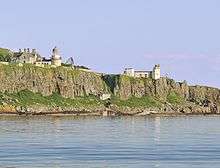Little Cumbrae
| Gaelic name | Cumaradh Beag |
|---|---|
| Meaning of name | Little island of the Cymric people[1] |
| Location | |
 Little Cumbrae Little Cumbrae shown within North Ayrshire | |
| OS grid reference | NS148517 |
| Physical geography | |
| Island group | Islands of the Clyde |
| Area | 313 hectares (1.21 sq mi) |
| Area rank | 84 [2] |
| Highest elevation | Lighthouse Hill 123 metres (404 ft) |
| Administration | |
| Sovereign state | United Kingdom |
| Country | Scotland |
| Council area | North Ayrshire |
| Demographics | |
| Population | 0 |
| References | [3][4][5] |
Little Cumbrae (Scots: Wee Cumbrae, Scottish Gaelic: Cumaradh Beag) is an island in the Firth of Clyde, in North Ayrshire, Scotland. The island is known locally as Wee Cumbrae.
Etymology
The Gaelic name Cumaradh means "place of the Cymric people", referring to the Brittonic-speaking inhabitants of the Kingdom of Strathclyde.[1] Alternatively, the name Cumbrae may derive from Kil Maura meaning "cell or church of a female saint".[6]
Little Cumbrae was recorded as Kumbrey circa 1300, Cumbraye circa 1330 and Litill Comeray in 1515[6] and was also formerly known as Little or Wee Cumray.[4]
The Cumbraes are referred to as the Kumreyiar in the Norse Saga of Haakon Haakonarson.[7]
Geography
Little Cumbrae lies barely a kilometre to the south of its larger neighbour, Great Cumbrae, a few kilometres distant from the mainland town of Largs. The islands are collectively referred to as The Cumbraes. In stark contrast to its neighbour, green and fertile Great Cumbrae, Little Cumbrae is a rough and rocky island. With its many cliffs and rocky outcrops, Little Cumbrae bears more of a resemblance to a Hebridean island than to some of its neighbours in the Clyde.
A number of uninhabited islets skirt the island's east coast, Castle Isle, the Broad Islands and Trail Isle.
Today the island's main settlement is at Little Cumbrae House on the eastern shore, facing the Scottish mainland.
History
 Little Cumbrae Lighthouse | |
| Location | Firth of Clyde |
|---|---|
| Coordinates | 55°43.2179′N 4°58.0236′W / 55.7202983°N 4.9670600°W |
| Year first constructed | 1793 |
| Year first lit | 1997 (current tower) |
| Automated | 1977 |
| Construction |
Traditional white tower (inoperative) |
| Focal height | 92 feet (28 m) |
| Range | nautical miles |
| Characteristic | Fl. W 6 sec |
Robert II is said to have built a castle on the island which was demolished by Cromwell's soldiers in 1653.[8]
In the early 20th century, under the ownership of Evelyn Stuart Parker, a new ‘mansion house’ was created from the original single storey farmhouse, the gardens were laid out to a plan by Gertrude Jekyll, the renowned garden designer, and substantial repairs were undertaken to the castle and the original lighthouse. The original work commenced in 1913, with subsequent alterations made between 1926 and 1929 when the square tower and top floor were added.
Little Cumbrae is the birthplace of James Archbald, the first mayor of Carbondale, Pennsylvania.
Cumbrae Lighthouse
James Ewing built the first Little Cumbrae lighthouse on the top of Lighthouse Hill in 1757. This was the second lighthouse in Scotland.[9] An open fire was lit at the top of a circular stone tower. Remains of this old structure can still be seen.
The traditional Cumbrae Lighthouse was built in 1793 by Thomas Smith under commission from the Commissioners of the Northern Lights. The lighthouse lies on a broad raised beach on the western shore of the island looking out into the Firth. It had a foghorn, slipway, jetty, and boathouse. The original oil lamps were replaced by Argand lamps in 1826 and a solar-powered light was installed in 1974.[9] The 1793 tower has been unused since 1997, with the light on 36-foot hexagonal/cylindrical tower adjacent to the old generator house.
Ownership
Little Cumbrae was privately purchased in 2003 and there were plans for its development as a memorial park, nature reserve and corporate escape.
The island was sold again in July 2009 for £2 million.[10] The buyers of the island, Scottish millionaire couple of Indian extraction, Sarwan and Sunita Poddar, opened there a yoga and meditation centre with the help of yoga guru Swami Baba Ramdev.[11][12] There have also been rumours of the new owners planning to rename it "Peace Island", but those have been denied.[13][14]
Footnotes
- 1 2 Mac an Tàilleir p. 36
- ↑ Area and population ranks: there are c. 300 islands over 20 ha in extent and 93 permanently inhabited islands were listed in the 2011 census.
- ↑ 2001 UK Census per List of islands of Scotland
- 1 2 Haswell-Smith (2004) pp. 17-18
- ↑ Ordnance Survey
- 1 2 Johnston, p. 93
- ↑ "cömbröɣ" "Brittonic Language in the Old North". Scottish Place-Name Society. Retrieved 14 September 2011.
- ↑ "Overview of Little Cumbrae". Gazetteer for Scotland. Retrieved 11 November 2007.
- 1 2 "Little Cumbrae". Secret Scotland. Retrieved 17 January 2011.
- ↑ "Little Cumbrae". HLL Humberts Leisure. 10 July 2009. Retrieved 12 July 2009.
- ↑ "'Gay cure' yoga guru to set up centre on Scottish island". Pink News. Retrieved 17 September 2009.
- ↑ Blakely, Rhys (8 September 2009). "Yoga guru sets up base on Scottish isle". London: Times Online. Retrieved 27 September 2009.
- ↑ "Plans about Little Cumbrae". Bramble & Bug Ltd. Retrieved 10 November 2009.
- ↑ "Little Cumbrae not to be renamed". Largs and Millport News. 16 September 2009. Retrieved 10 November 2009.
References
- Haswell-Smith, Hamish (2004). The Scottish Islands. Edinburgh: Canongate. ISBN 978-1-84195-454-7.
- Johnston, J. B. (1903). Place-names of Scotland. Edinburgh: David Douglas.
- Iain Mac an Tàilleir. "Placenames" (pdf). Pàrlamaid na h-Alba. Retrieved 23 July 2010.
External links
Coordinates: 55°43′17″N 4°57′18″W / 55.72131°N 4.95503°W
